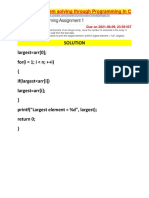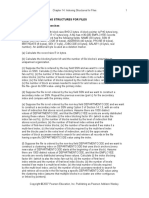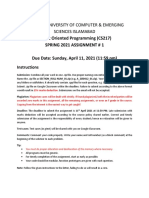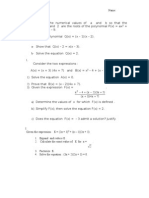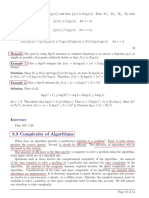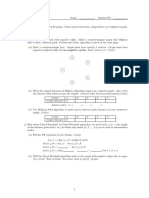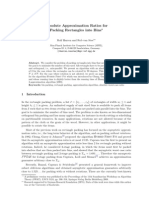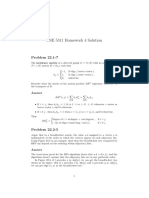Final Exam Summer A 19 Complete
Final Exam Summer A 19 Complete
Uploaded by
api-335458084Copyright:
Available Formats
Final Exam Summer A 19 Complete
Final Exam Summer A 19 Complete
Uploaded by
api-335458084Original Title
Copyright
Available Formats
Share this document
Did you find this document useful?
Is this content inappropriate?
Copyright:
Available Formats
Final Exam Summer A 19 Complete
Final Exam Summer A 19 Complete
Uploaded by
api-335458084Copyright:
Available Formats
CST 370 Design and Analysis of Algorithms
Summer A 2019
Final Exam
Name: Sean Figel
Four-digits ID: 0507
Test time is 2 hours and 30 minutes.
Note that there are 12 problems in the final exam.
This is a closed book exam. You can’t use a calculator during the
exam. However, as a reference during the exam, you can prepare “two
pages (= total of 4 sides)” cheat sheet. The cheat sheet can be typed or
hand-written.
If possible, enter your answers directly into the Word file to increase the
readability of your answers. However, if it is too difficult or time
consuming to type in a Word file, please write down your answer on
paper. Then, take a picture and insert the picture into the Word file.
During the exam, you must sign into the Zoom session and turn on the
video and turn off the audio. We will record the whole zoom session.
If you have a question during the exam, please use "Chat" in Zoom. I will
answer as soon as possible.
When you finish the exam, submit your Word file (and an optional PDF
file) on the iLearn. But keep the Word file well in case we need it.
Use your time wisely—make sure to answer the questions you know first.
Read the questions carefully.
CST370 Page 1 of 9 Final Exam
1. (1 point) Assume that Dr. Byun assigned a programming project which requires the time
complexity of O(n2). If your program’s basic operation runs (n*logn + 2*n + 75) times, can you
say that your program meets the project requirement? (Yes/No). Yes
2. (2 points) (a) Based on our class’s definition, this is a graph. (True/False) Yes
(b) This is an AVL tree. (True/False) No
(c) This is a max heap. (True/False) No
3. (1 point) Consider the following master theorem:
T(n) = aT(n/b) + f (n) where f(n) (nd), d 0
Master Theorem: If a < bd, T(n) (nd)
If a = bd, T(n) (nd log n)
If a > bd, T(n) (nlogba )
Based on the theorem, determine the time efficiency of the following formula T(n).
(a) T(n) = 2 * T(n/2) + n2
(b) T(n) = 4 * T(n/2) + 5n
CST370 Page 2 of 9 Final Exam
4. (3 points) Solve the following recurrence relation using the backward substitution as we
learned in the class. In the problem, you should present the intermediate steps and time
complexity of the recurrence relation.
M(n) = 2 * M(n − 1) + 2, for n > 0 // recurrence relation
M(1) = 2 // initial condition
5. (2 points) Draw all possible AVL trees with 4 nodes of the key values 10, 15, 20, and 25 that
satisfy the balance requirement of AVL trees.
CST370 Page 3 of 9 Final Exam
6. (3 points) Suppose you have three jars, A, B, and C, in a room. Jar A has 5 large black balls, 3
large red balls, and 2 large green balls. Jar B has 4 small black balls, 3 small red balls, and 2
small green balls. Jar C is empty. Thus, there are total 19 balls. Now, you will pick a few balls
from the jar A in the dark and place them in the jar C. After that, you will pick a few balls from
the jar B in the dark and place them in the jar C. Note that the color of the selected balls at the jars
A and B can not be confirmed because the surroundings are dark. Also, the numbers of balls
selected from the jars A and B need not always be the same. Once you're done, you can turn on
the lights in the room and see the balls in the jar C.
(a) Assuming the worst case occurs, what is the minimum number of balls you have to choose to
get a matching pair? Here, a matching pair means that there must be one large ball and one
small ball of the same color in the jar C. But the color itself of the pair is not important. Present
just the number of balls. You don’t need to explain your answer.
9 balls need to be pulled, 8 from Jar B and 1 from Jar A.
(b) Assuming the best case occurs, what is the minimum number of balls you have to choose to
get three matching pairs of each color (= black, red, green)? In other words, you should have
one pair of large and small black balls, one pair of large and small red balls, and one pair of large
and small green balls. Present just the number of balls. You don’t need to explain your
answer.
6 balls
(c) Assuming the worst case occurs, what is the minimum number of balls you have to choose to
get three matching pairs of each color (= black, red, green)? In other words, you should have
one pair of large and small black balls, one pair of large and small red balls, and one pair of large
and small green balls. Present just the number of balls. You don’t need to explain your
answer.
17
CST370 Page 4 of 9 Final Exam
7. (2 points) Draw a binary tree with ten nodes labeled 0, 1, 2, ..., 9 in such a way that the inorder
and preorder traversals of the tree yield the following lists:
6, 7, 9, 4, 8, 1, 5, 0, 2, 3 (inorder)
5, 4, 7, 6, 9, 1, 8, 2, 0, 3 (preorder).
Note that the problem is asking to draw only one binary tree. If you can’t completely draw a
binary tree with the given information, explain why.
8. (2 points) (a) Remove the max value from the following heap.
(b) Add 55 to the following heap.
CST370 Page 5 of 9 Final Exam
9. (2 points) Apply the Warshall’s algorithm to get the transitive closure of the digraph defined by
the following graph. Present R(0), R(1), R(2), R(3), and R(4) as we discussed in the class.
1 2
3 4
CST370 Page 6 of 9 Final Exam
10. (3 points) Assume that you are going to solve the MST (Minimum Spanning Tree) problem
using the Prim’s algorithm for the following graph. Draw the final MST. For the problem, you
have to start from the vertex a. You must also provide the sequence of vertices to be added to the
"visited" set as we covered in the class.
CST370 Page 7 of 9 Final Exam
11. (3 points) Assume that you are going to solve the single-source shortest-paths problem using
the Dijkstra’s algorithm for the following graph. For the problem, you should start from the
vertex a. Fill out the table as you learned in the class.
a 5 c
4 2 3
2
b 1 d 6 e
V a b c d e
a 0a
CST370 Page 8 of 9 Final Exam
12. (3 points) Assume that you want to calculate 2n where n is a positive integer using a
decrease-and-conquer (or divide-and-conquer) algorithm. For example, if the algorithm
receives an input value 3 for n, it should return 8 (= 23). As another example, if the algorithm
receives an input value 1, it should return 2 (= 21).
(a) Describe the basic idea of your decrease-and-conquer (or divide-and-conquer) algorithm in
English.
Subtract n until n = 1. Return two and multiply the return by two and return again until the
algorithm has multiplied 2n
(b) Based on the basic idea of (a), write a pseudocode of your algorithm. If you want, you can
write your algorithm in C++ code.
Int twoPower(int n)
{
If(n == 1)
{
Return 2;
{
Else
{
Return 2 * twoPower(n -1);
}
}
CST370 Page 9 of 9 Final Exam
You might also like
- CST 370 Final ExamDocument7 pagesCST 370 Final ExamJosh JonesNo ratings yet
- IS4241 - RevisionDocument13 pagesIS4241 - RevisionjieboNo ratings yet
- Measures of Location and Spread - Test A (55 Mins) : C T C CDocument1 pageMeasures of Location and Spread - Test A (55 Mins) : C T C CHo Lam, Trish Lau0% (1)
- Structures and Unions in C: Slides Taken From: Alan L. Cox Computer Science Department Rice University TexasDocument11 pagesStructures and Unions in C: Slides Taken From: Alan L. Cox Computer Science Department Rice University TexasRajan JaiprakashNo ratings yet
- Practice ExamDocument15 pagesPractice ExamDart-44No ratings yet
- CSE132A Solutions HW 1: Sname Sid Pid Color RedDocument5 pagesCSE132A Solutions HW 1: Sname Sid Pid Color RedMaya JennyNo ratings yet
- Mcdermott 6014 Final Summer B 17Document14 pagesMcdermott 6014 Final Summer B 17api-373102817No ratings yet
- Solu 8Document35 pagesSolu 8Basil Aziz TinahNo ratings yet
- Test 2 2022CDocument2 pagesTest 2 2022Cbruh65768y79No ratings yet
- Cs 143 Sample MidDocument4 pagesCs 143 Sample MidSeungdo LeeNo ratings yet
- 19MT1201 MFE Session Problems 2019 - 20Document22 pages19MT1201 MFE Session Problems 2019 - 20sai tejaNo ratings yet
- CST 370 - Spring A 2020 Homework 3: Answer: 1Document4 pagesCST 370 - Spring A 2020 Homework 3: Answer: 1api-427618266No ratings yet
- Practice Problem 2Document3 pagesPractice Problem 2rajatchikuNo ratings yet
- 5 Color TheoremDocument17 pages5 Color TheoremAnastasia IndrieNo ratings yet
- Array Sample QuestionsDocument12 pagesArray Sample QuestionsSvLabNo ratings yet
- Programming Assignment 4 Steps 1 - 5Document9 pagesProgramming Assignment 4 Steps 1 - 5api-526463519No ratings yet
- Space and Time Trade OffDocument8 pagesSpace and Time Trade OffSheshnath HadbeNo ratings yet
- Assignment # 3Document4 pagesAssignment # 3Shahzael MughalNo ratings yet
- Problem Solving Through Programming in C Week 6 Programming AssignmentDocument4 pagesProblem Solving Through Programming in C Week 6 Programming AssignmentPurushottam SharmaNo ratings yet
- Practice AssignmentDocument4 pagesPractice Assignmentshriya2413No ratings yet
- DMDW-Solution For Unit 1-5Document20 pagesDMDW-Solution For Unit 1-5Manish Arya50% (2)
- Chap 8 NLPDocument64 pagesChap 8 NLPAnup MohapatraNo ratings yet
- Chapter 14: Indexing Structures For Files: Answers To Selected ExercisesDocument8 pagesChapter 14: Indexing Structures For Files: Answers To Selected ExercisesChad ChristensenNo ratings yet
- Sma 2100 Discrete MathematicsDocument4 pagesSma 2100 Discrete MathematicsJoseph NjugunaNo ratings yet
- Logical Venn DiagramDocument22 pagesLogical Venn DiagramShivam GoyalNo ratings yet
- Assignment 1: The University of The West IndiesDocument14 pagesAssignment 1: The University of The West IndiesjevanjuniorNo ratings yet
- The Complete Proof of Knapsack Problem Is NP - CompletenessDocument5 pagesThe Complete Proof of Knapsack Problem Is NP - CompletenessFrank WangNo ratings yet
- 4.2 Relations, Functions, Domain & Range QuizDocument6 pages4.2 Relations, Functions, Domain & Range QuizSETHNo ratings yet
- COAL LAB Manual 2 FAST NUCESDocument3 pagesCOAL LAB Manual 2 FAST NUCESAmeer HamzaNo ratings yet
- StrelDocument17 pagesStrelAhmad BasNo ratings yet
- 2010 AJC Paper 2Document5 pages2010 AJC Paper 2Fang Wen LimNo ratings yet
- Tutorial 3 Lab 3Document4 pagesTutorial 3 Lab 3Sohar AlkindiNo ratings yet
- JU NCPC 2023 - Preliminary Contest OnlineDocument14 pagesJU NCPC 2023 - Preliminary Contest Onlinerakib.cse.202102040270% (1)
- Midterm1 Sample SolDocument4 pagesMidterm1 Sample SolSnehaNo ratings yet
- N Queen ProblemDocument12 pagesN Queen ProblemShrinath TailorNo ratings yet
- New Microsoft Word DocumentDocument3 pagesNew Microsoft Word Documentapi-586390371No ratings yet
- Infosys-Specialist-Programmer-Previous QuestionsDocument13 pagesInfosys-Specialist-Programmer-Previous Questions20ag1a6716No ratings yet
- Coding Decoding Quiz 78Document5 pagesCoding Decoding Quiz 78jr.naga0523No ratings yet
- Daa AssignmentDocument5 pagesDaa Assignmentrohith reddyNo ratings yet
- Prims and Kruskal's Algorithm ProblemDocument13 pagesPrims and Kruskal's Algorithm ProblemGunjanNo ratings yet
- Assignment On Image Processing - 2Document2 pagesAssignment On Image Processing - 2kfrahmanNo ratings yet
- Lab 2 - Function and ArrayDocument4 pagesLab 2 - Function and Arrayananyasri.upadhyaNo ratings yet
- 17 Dynamic Programming Matrix Chain Multiplication No PauseDocument32 pages17 Dynamic Programming Matrix Chain Multiplication No PauseAbdallahi SidiNo ratings yet
- Preprocessor Directives: Separate Step in The Compilation ProcessDocument40 pagesPreprocessor Directives: Separate Step in The Compilation ProcesssabapathiNo ratings yet
- Exercises of Design & AnalysisDocument6 pagesExercises of Design & AnalysisKhang NguyễnNo ratings yet
- Errata Digital Communications: John G. Proakis and Masoud Salehi Fifth Edition, Mcgraw-Hill, 2008Document3 pagesErrata Digital Communications: John G. Proakis and Masoud Salehi Fifth Edition, Mcgraw-Hill, 2008Rasha ZiyadNo ratings yet
- Question BankDocument7 pagesQuestion BankraghuvsbNo ratings yet
- Master TheoremDocument12 pagesMaster TheoremMian OsamaNo ratings yet
- OOP - Assignment - 1 - Spring 2021Document4 pagesOOP - Assignment - 1 - Spring 2021Maryam ZulfiqarNo ratings yet
- CPS125 - Course GuideDocument60 pagesCPS125 - Course GuideAnonymous DGsUhIaZNo ratings yet
- Let Us C Chapter 1 PDFDocument13 pagesLet Us C Chapter 1 PDFdeepakNo ratings yet
- IB Questionbank - SL Logs WsDocument10 pagesIB Questionbank - SL Logs WsEmNo ratings yet
- MCA 312 Design&Analysis of Algorithm QuestionBankDocument7 pagesMCA 312 Design&Analysis of Algorithm QuestionBanknbprNo ratings yet
- Order of Complexity AnalysisDocument9 pagesOrder of Complexity AnalysisMusic LifeNo ratings yet
- Worksheet BrevetDocument5 pagesWorksheet Brevetcaroline_amideast8101No ratings yet
- c3 Practicetest4 2223 PDFDocument4 pagesc3 Practicetest4 2223 PDFalex renNo ratings yet
- 3.3 Complexity of Algorithms: ExercisesDocument3 pages3.3 Complexity of Algorithms: Exerciseslixus mwangiNo ratings yet
- Alleyn's School 13+ English Sample Examination Paper 1Document14 pagesAlleyn's School 13+ English Sample Examination Paper 1lusavkaNo ratings yet
- 2022 Spring CS300 FinalDocument11 pages2022 Spring CS300 FinalyunajessiNo ratings yet
- Math 30-2 Practice Final Exam - 1 - RevisedDocument17 pagesMath 30-2 Practice Final Exam - 1 - RevisedLaura AkamNo ratings yet
- Discrete Mathematics Discrete Mathematics: - Chapter 9: Generating FunctionDocument45 pagesDiscrete Mathematics Discrete Mathematics: - Chapter 9: Generating FunctionAshish SinghNo ratings yet
- Grade 9 Number System in PDFDocument3 pagesGrade 9 Number System in PDFshyamNo ratings yet
- Vieta JumpingDocument7 pagesVieta Jumpingvincenthuang75025No ratings yet
- Z Transform Pairs and PropertiesDocument2 pagesZ Transform Pairs and PropertiesAicha CherNo ratings yet
- Exam 3 Math 170Document5 pagesExam 3 Math 170hthaier4062No ratings yet
- 10th Bay Area Mathematical Olympiad: Problems (With Solutions)Document4 pages10th Bay Area Mathematical Olympiad: Problems (With Solutions)Shamim AkhtarNo ratings yet
- LPPDocument8 pagesLPPshinde_jayesh2005No ratings yet
- Discriminant b2 4acDocument14 pagesDiscriminant b2 4acIr HeriawanNo ratings yet
- FDocument12 pagesFivanNo ratings yet
- Arithmetic-Operations - Class 5Document2 pagesArithmetic-Operations - Class 5Kritika AroraNo ratings yet
- Topics: Block Placement. Global Routing. Switchbox RoutingDocument24 pagesTopics: Block Placement. Global Routing. Switchbox RoutingprateekNo ratings yet
- Mei Structured Mathematics: Introduction To Advanced Mathematics, C1Document4 pagesMei Structured Mathematics: Introduction To Advanced Mathematics, C1keyitsmeNo ratings yet
- Residue Number SystemsDocument45 pagesResidue Number SystemsMeera Bommi MNo ratings yet
- Algorithms and Data Structures: Binary Search AlgorithmDocument3 pagesAlgorithms and Data Structures: Binary Search AlgorithmMalik ArslanNo ratings yet
- MATH10 - 1st PERIODICAL EXAMDocument3 pagesMATH10 - 1st PERIODICAL EXAMjohnmark.calmaNo ratings yet
- Data Structure and Algorithms: Travelling Salesman Problem Using Dynamic ProgramingDocument15 pagesData Structure and Algorithms: Travelling Salesman Problem Using Dynamic ProgramingChahat SharmaNo ratings yet
- Peter Maandag 3047121 Solving 3-SatDocument37 pagesPeter Maandag 3047121 Solving 3-SatAjay SonkarNo ratings yet
- Notes UNIT2 Recurrence Relations MTH401Document29 pagesNotes UNIT2 Recurrence Relations MTH401Aman KumarNo ratings yet
- Rolf Harren and Rob Van Stee - Absolute Approximation Ratios For Packing Rectangles Into BinsDocument19 pagesRolf Harren and Rob Van Stee - Absolute Approximation Ratios For Packing Rectangles Into BinsMnaomNo ratings yet
- Algorithm and FlowchartDocument5 pagesAlgorithm and Flowchartanish.t.pNo ratings yet
- Numerical Methods Question BankDocument64 pagesNumerical Methods Question Bankshanakiyan60% (10)
- Assignment 1Document1 pageAssignment 1shashm024No ratings yet
- MTH401 #Zero Lecture: Discrete MathematicsDocument26 pagesMTH401 #Zero Lecture: Discrete MathematicsChanchal AlamNo ratings yet
- Namma Kalvi 10th Maths Chapter 2 Ganga Maths Guide em PDFDocument54 pagesNamma Kalvi 10th Maths Chapter 2 Ganga Maths Guide em PDFDavidNo ratings yet
- National 2017 - SolutionsDocument5 pagesNational 2017 - SolutionsOfelia Aljade RamosNo ratings yet
- Number System Sheet-1Document10 pagesNumber System Sheet-1SOURAVNo ratings yet
- Lesson 3 Permutation and CombinationDocument15 pagesLesson 3 Permutation and Combinationleaadel92No ratings yet
- Data Structures Module 3Document10 pagesData Structures Module 3santhoshsubramaniyaNo ratings yet
- CSE 5311 Homework 4 Solution: Problem 22.1-7Document5 pagesCSE 5311 Homework 4 Solution: Problem 22.1-7Prateek RaawatNo ratings yet


















